EI Self-Employment Creative Ad Concept Testing
POR-017-10
Contract No. G9178-100001/003/CY
Contract date: 2010-08-06
November 2, 2010
Prepared for
Human Resources and Skills Development Canada
nc-por-rop-gd@hrsdc-rhdcc.gc.ca
Executive Summary
Ce rapport est disponible en français sur demande.
Prepared by:
tns canadian facts
Executive Summary
Background and Objectives
- Under the Employment Insurance Act, as amended by the Fairness for the Self-Employed Act, self-employed Canadians can now apply for special benefits when they register for access to the Employment Insurance (EI) program. While these benefits are new in most of the country, self-employed residents of Quebec were already covered for maternity and parental benefits under the Quebec Parental Insurance Plan (QPIP). Quebec residents are now eligible to apply for EI sickness and compassionate care benefits only under this new measure.
- In Year 1 of this initiative, self-employed creative and messaging were included as part of both the national and regional EAP advertising campaign (TV, radio, print and Internet) in early 2010. Year 2 will build on the established momentum outside of the Economic Action Plan (EAP) umbrella, as these benefits will outlive the EAP program.
- The overall objective of the research was to enable HRSDC to develop advertising that resonates with self-employed Canadians and allows them to be aware of and take full advantage of these program benefits which are now available to them.
The specific objectives of this research were:
- To test three (3) draft advertising concepts for clarity, credibility, overall impact, effectiveness in relation to call to action, as well as obtain suggestions for improvements.
- To evaluate the degree to which each concept is effective on key advertising effectiveness measures including involvement, motivation, likeability, relevance, credibility, differentiation, persuasion, confusion, and irritability.
- To select which of the three draft advertising concepts is the most effective at achieving communications objectives.
Approach and Methodology
- A quantitative online advertising pre-test survey was conducted among self-employed Canadians between the age of 25 and 55 using the TNS Canadian Facts proprietary Interactive panel. The research design is based on TNS’s AdEval advertising effectiveness methodology.
- Each respondent evaluated one single concept thoroughly, which included a print and online banner ad creative component. This provided an unbiased diagnostic for all concepts being tested. The sample was therefore divided into 3 equal cells, with each cell being assigned a specific concept.
- Respondents were first asked a number of awareness and attitudinal questions regarding the Canadian Employment Insurance program. They were then shown one of the creative concepts, followed by a series of diagnostic questions on that particular concept, and specific creative within each concept. Following this section of the survey, respondents were asked to answer again the awareness and attitudinal questions they were shown at the beginning of the survey – in order to measure the impact of the campaign pre vs. post exposure. Finally, respondents were shown all three concepts and answered a few final questions in a head-to-head comparison.
- The survey was launched on September 8, 2010 and by September 20, a total of 653 interviews were completed. The following is the breakdown of final completions by concept:
- Greeting Cards: 208 completions
- It Works: 217 completions
- Work/Life Balance: 228 completions
- Prior to the conduct of any data analysis the data set was checked and cleaned to ensure that all responses were valid, logical and accurate. The clean data set, comprising 653 cases was weighted to be representative of the population of self-employed Canadians by age, gender and region.
- The key analytical variables used in drafting this report and for which detailed data tables have been created are as follows:
- Region: Atlantic, Quebec, Ontario, Prairies and British Columbia
- Household income: Less than $35,000, $35,000 to $79,999, or $80,000 and higher
- Gender: Male or female
- Age: 18-24, 25-34, 35-44, 45-54
- Age of children in household: 0-6, 7-12, 13-16
- N.B. The absence of reporting on comparative analysis does not mean that the analysis was not undertaken, but rather that the analysis revealed that there were no significant differences from one group to another and indicate that the results are similar to the (sample) population on the whole.
- It should be noted that when concepts are examined on an individual basis, certain segments contain a small number of respondents and may not be representative of the general population.
- Since the sample was drawn from a proprietary panel in which panel members were recruited and incented to participate, this does not represent a probability sample and therefore, margin of error calculations do not apply.
Political Neutrality Certification
I hereby certify as Senior Officer of TNS Canadian Facts that the deliverables fully comply with the Government of Canada political neutrality requirements outlined in the Communications Policy of the Government of Canada and Procedures for Planning and Contracting Public Opinion Research. Specifically, the deliverables do not include information on electoral voting intentions, political party preferences, standings with the electorate or ratings of the performance of a political party or its leaders.
Signed
Norman Baillie-David, CMRP
Vice President, Director of Public Opinion Research
Total Study Cost
The total cost of this study, excluding HST, amounted to $24,025.21.
Findings
Overall Ad Likeability
- “It Works” and “Work/Life Balance” are getting the highest score on overall likeability, with 52% and 51% “like very much” respectively vs. 43% for “Greeting Cards”. These results are well above the TNS norm.
Importance of Message
- Here again, “It Works” and “Work/Life Balance” appear to be communicating a message that resonates more with the target audience. Nearly two-thirds feel that the message in the ad is “very important” (61% for “It Works” and 57% for “Work/Life Balance” vs. 49%) for “Greeting Cards.”
Ad Diagnostic
- When asked to rate the creative concept on a series of dimensions, “It Works” outperforms the other two concepts on a few metrics:
- Made me want to get more information: 83% vs. 74% for “Work/Life Balance” and 75% for “Greeting Cards”
- The ad would grab my attention: 81% vs. 71% for “Work/Life Balance” and 72% for “Greeting Cards”
- Felt involved in what I saw: 69% vs. 62% for “Work/Life Balance” and 67% for “Greeting Cards”.
- For its part, “Work/Life Balance” scores the highest in terms of believability (75% vs. 74% for “It Works” and 62% for “Greeting Cards”).
Campaign Message Communication: “It Works” Communicates the Message Best
- “It Works” clearly outperforms “Work/Life Balance” and either outperforms or is on par with “Greeting Cards” when it comes to making it clear that:
- New EI benefits are now available for self-employed Canadians (88% vs. 77-81%)
- Information is available online or by phone (81% vs. 71%-74%)
- Eligibility for EI depends on your personal situation (52% vs. 45%-46%)
- That said, all three concepts score poorly in terms of communicating that “EI benefits for the self-employed may not be right for me, given my personal situation.” This represents a potential risk in terms of setting expectations with regard to potential eligibility, and is perhaps something that could be reinforced when finalizing the winning creative.
Head-to-Head Concept Comparison
- As mentioned earlier, “It Works” gets the edge over the two other concepts when survey respondents are shown all three concepts one after the other and asked which of the three they prefer. Overall, 43% prefer “It Works”, while 33% selected “Work/Life Balance” and 24% choose “Greeting Cards”.
- More importantly however, when asked which of the three best communicates the key campaign messages, “It Works” clearly stands out from the other two, getting between 42% and 55% of the votes depending on the message.
English Creative Ad Concepts
Work/Life Balance

Text description de la Figure 1: Work/Life Balance

Text description of Figure 2: Work/Life Balance
Greeting Cards
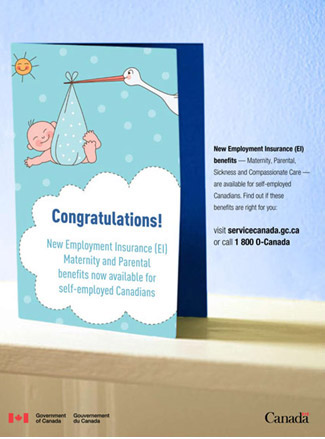
Text description of Figure 3: Greeting Cards
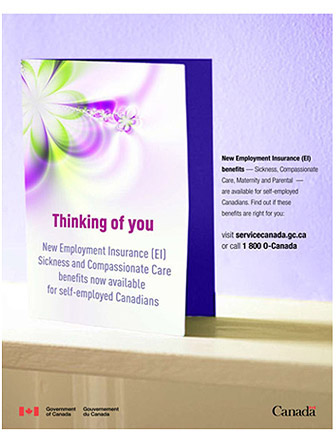
Text description of Figure 4: Greeting Cards
It Works

Text description of Figure 5: It Works
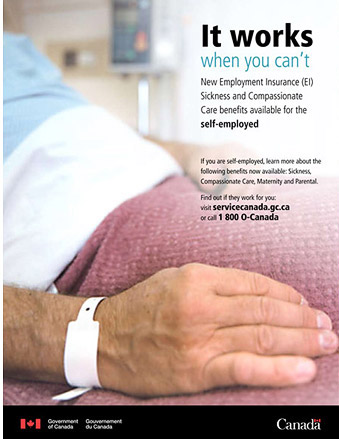
Text description of Figure 6: It Works
French Creative Ad Concepts
Concilier travail et vie professionnelle

Text description de la figure 1: Concilier travail et vie professionnelle

Text description de la figure 2: Concilier travail et vie professionnelle
Cartes de souhaits
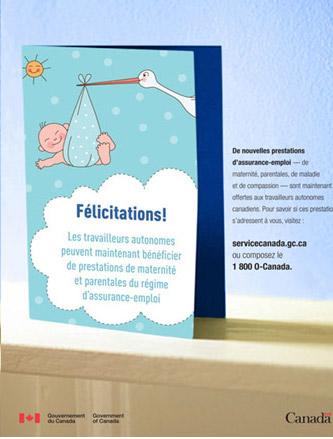
Text description de la Figure 3: Cartes de souhaits
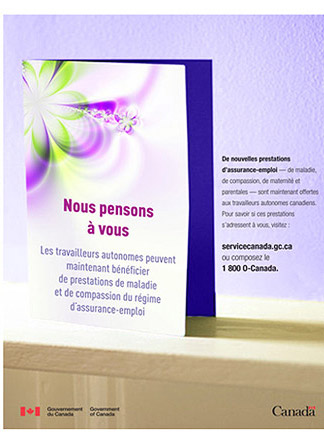
Text description de la Figure 4: Cartes de souhaits
Elles travaillent
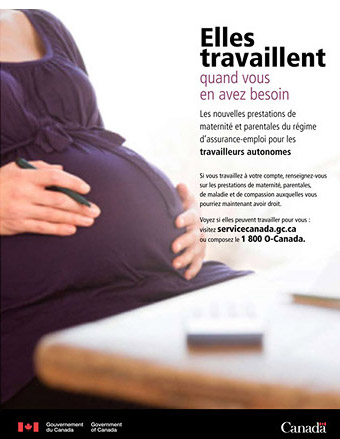
Text description de la Figure 5: Elles travaillent
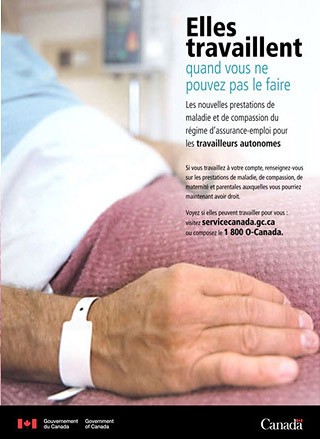
Text description de la Figure 6: Elles travaillent
Recommendations
While all three advertising concepts have good potential given the results from the Ad Test quantitative survey, the “It Works” concept distinguishes itself as the recommended concept based on the head-to-head comparison and on certain key ad diagnostics.












